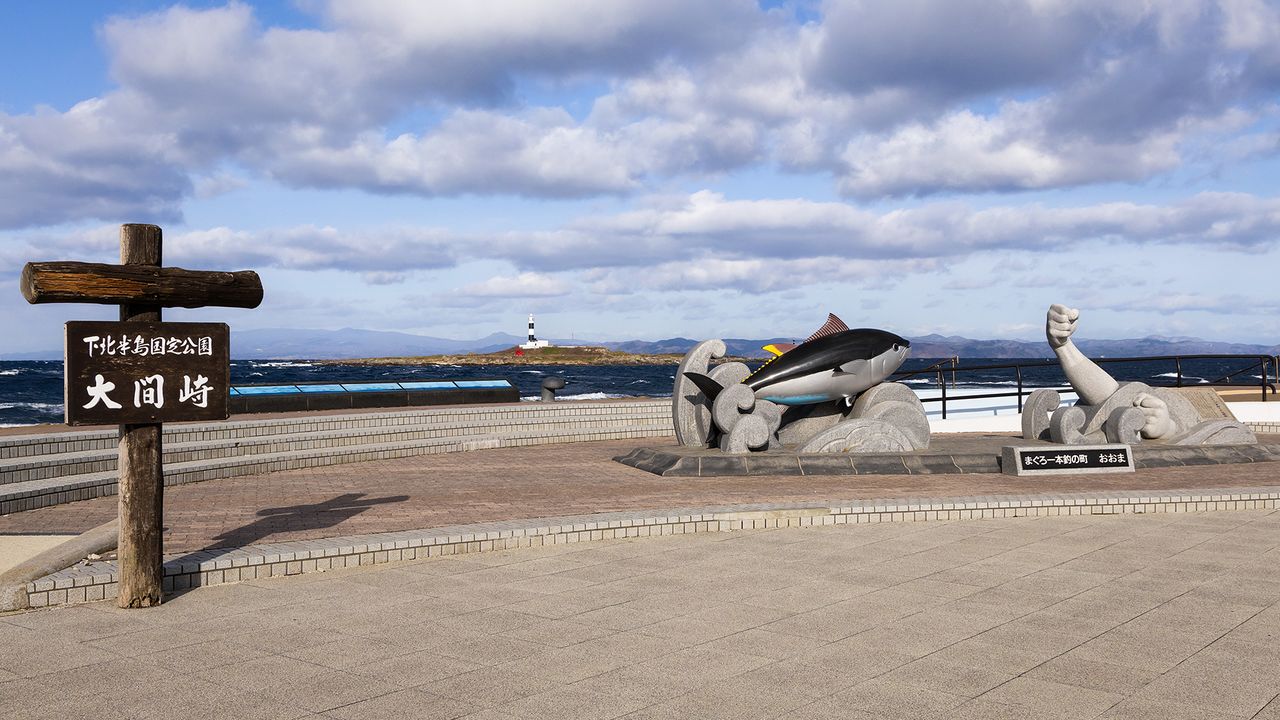
Ōma, Aomori Prefecture: Home of Japan’s Most Sought-After Tuna
Guideto Japan
Travel Food and Drink- English
- 日本語
- 简体字
- 繁體字
- Français
- Español
- العربية
- Русский
Top Auction Tuna for 13 Years Running
One of the first big news stories in Japan each January is the first auction of the new year at the Tokyo central wholesale market, now operating from its new premises at Toyosu. This year, the fish that made the headlines was a stunning tuna caught in the waters off the northern town of Ōma, Aomori Prefecture, which sold for over ¥114 million. This marked the thirteenth consecutive year that Ōma’s fishermen had taken the laurels. In 2019, a 278-kilogram tuna landed in Ōma made headlines around the world when it sold for ¥336.6 million—the highest price ever paid for a single specimen.

This prize tuna sold for ¥114.24 million at the first auction of 2024. The black sticker on the gills identifies the fish as “Ōma tuna.” The town’s name has become a byword for quality. (© Jiji)
Ōma has become a sought-after brand name, providing the finest-quality tuna to restaurants around the country. The fishing port is a small town of around 5,000 people at the northernmost point on Honshū, at the tip of the Shimokita Peninsula in Aomori Prefecture.
The town hardly enjoys the ideal setting for a tourist destination. The nearest station is JR Shimokita in Mutsu, an hour’s drive away, and the journey from the prefectural capital of Aomori takes nearly three hours. But this doesn’t deter food-lovers from making the trek to this isolated town in search of some of the freshest tuna available anywhere. Visitors are also drawn to Ōma by a long-running television show that follows the ups and downs of the town’s fishermen as they prowl the icy waters in search of their lucrative, silvery prey.
A popular alternative to the long journey from Aomori is to travel via Hakodate in Hokkaidō, from where regular ferries zip across the Tsugaru Strait and reach Ōma in just an hour and a half. Many people combine the two destinations, gorging on crab, salmon roe (ikura), and sea urchin in Hakodate before crossing over to feast on Ōma tuna. It’s the ultimate pleasure cruise for any seafood lover.
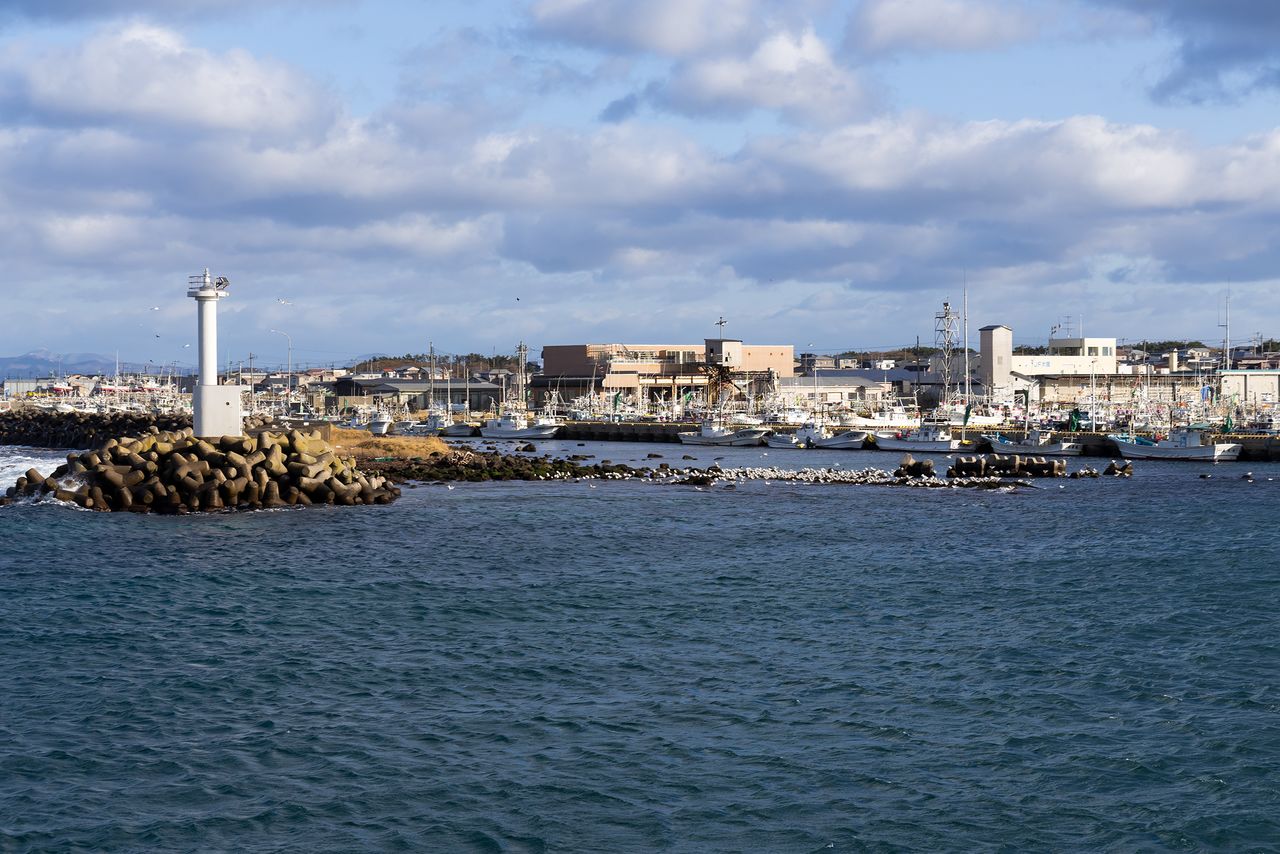
Ōma fishing port. The white building on the right of the picture is the Ōma Fisheries Cooperative. (© Nippon.com)
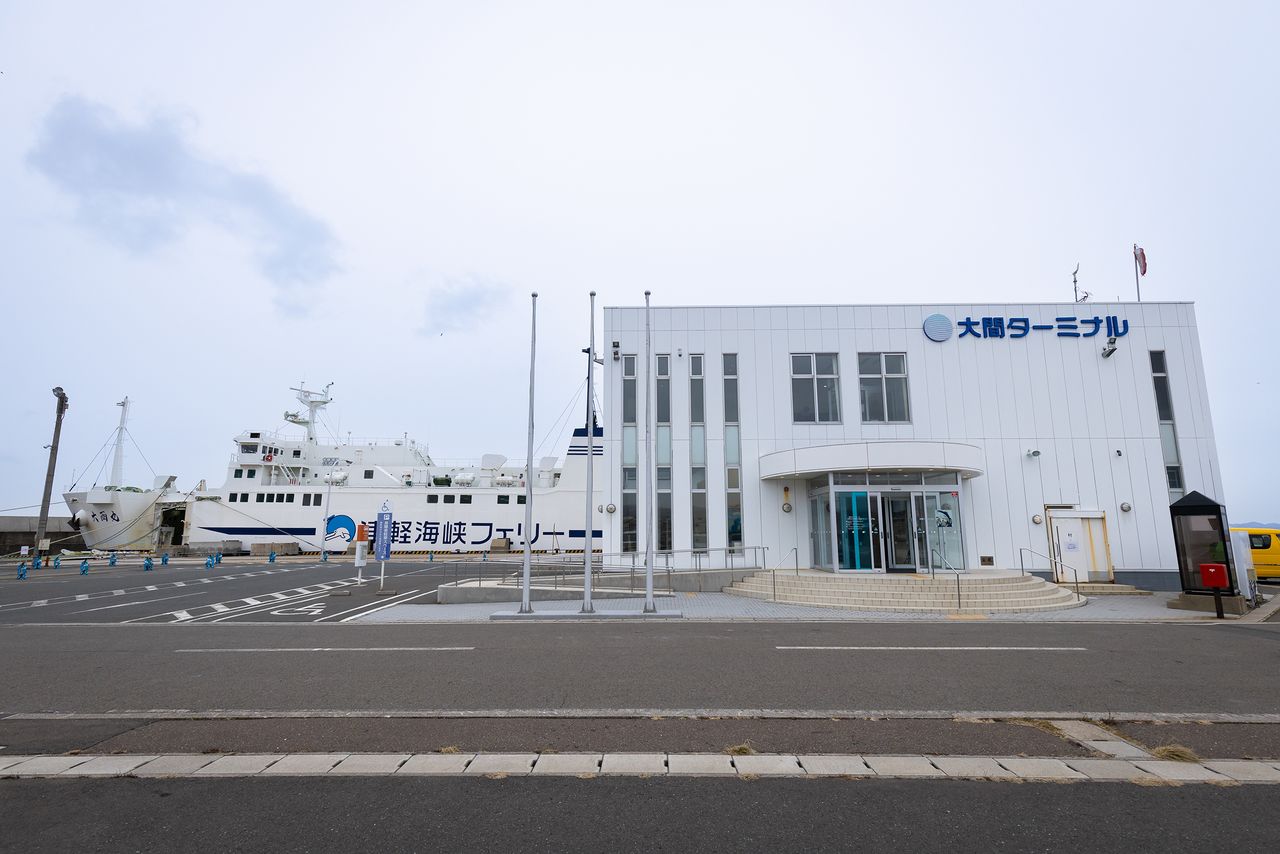
Ōma terminal and the Tsugaru Kaikyō ferry that plies the route between Honshū and Hokkaidō. A rental car office is also nearby. (© Nippon.com)
Foodie Paradise at the Northernmost Tip of Honshū
One must-see stop on any visit to Ōma is the stone marker overlooking the Tsugaru Strait, declaring the cape to be the northernmost point on the island of Honshū. Beyond the sea lies Hokkaidō. Next to the marker is a statue of the biggest fish caught here in living memory: a giant tuna that weighed in at 440 kilograms. The marker and statue are a popular spot for photos.

Welcome to the northernmost point on the island of Honshū. (© Nippon.com)
The Tsugaru Strait connects the Pacific Ocean with the Sea of Japan. On the Pacific side close to Ōma, the warm Kuroshio current merges with the cold-water Oyashio current. Into this flow the warmer waters of the Tsugaru current. The seas here are rich in plankton and other nutrients, and support large schools of the small fish and squid that tuna feed on.
Tuna visit the local waters from late summer into winter. Fish are at their plumpest at this time of year, having built up their fat reserves in anticipation of the colder weather. Winter tuna that have eaten their fill of oily fish and squid are especially prized for the fatty ō-toro and chū-toro cuts of belly meat.

This monument depicts the epic struggle between local fishermen and the record-breaking 440-kilogram tuna. (© Nippon.com)
Across the Tsugaru Strait, the range of mountains that stretches to the east of Hakodate can be made out on the Hokkaidō side. Ōma lighthouse on the small offshore island of Bentenjima has been voted one of the most scenic 50 lighthouses in Japan. The lighthouse’s austere two-tone black-and-white striped design makes a vibrant contrast with the vermilion of the island’s Shintō Benten shrine.
In the years before the lighthouse was built, the poet Ishikawa Takuboku, who lived in Hakodate for a time, was moved to write one of his most famous verses during a visit to Cape Ōma. A monument inscribed with this verse attracts his fans to this day.
On a patch of white sand on the rocky shore
of this small island in the eastern seas
damp with my own tears, I play with the crabs

The red building to the left of the Cape Ōma lighthouse is the Benten Shintō shrine. Beyond the island, the mountains of Hakodate can be seen. From here, it is just 17.5 kilometers to Cape Shiokubi on Hokkaidō. (© Nippon.com)

These stone markers commemorate the visit of Ishikawa Takuboku. Ōmori beach in Hakodate also claims to be the site that inspired his famous verse. Traveling by ferry allows poetry-lovers to visit both sites, just to be on the safe side. (© Nippon.com)
The area around the cape is littered with the usual array of stalls and shops selling seafood and souvenirs. The Ōma Tourist Souvenir Center offers a wide selection of processed seafood products, “Ōma tuna” stickers, and other local souvenirs. One popular item is a certificate commemorating the holder’s visit to the northernmost point in Honshū.
Nearby, the seafood restaurant Ōmanzoku—whose name is a play on the name of the town and a term meaning “great satisfaction”—offers a range of menu options featuring the local delicacy, including a reasonably priced fried tuna lunch set (¥1,390 including tax) whose generous portions of tender fish-and-chips-style tuna will satisfy the most demanding of maguro-lovers.

The Ōma Tourist Souvenir Center sells a range of seafood products and fluffy souvenirs. One popular choice is the certificates (top right) showing that the holder has visited the northernmost point in Honshū (¥200). (© Nippon.com)
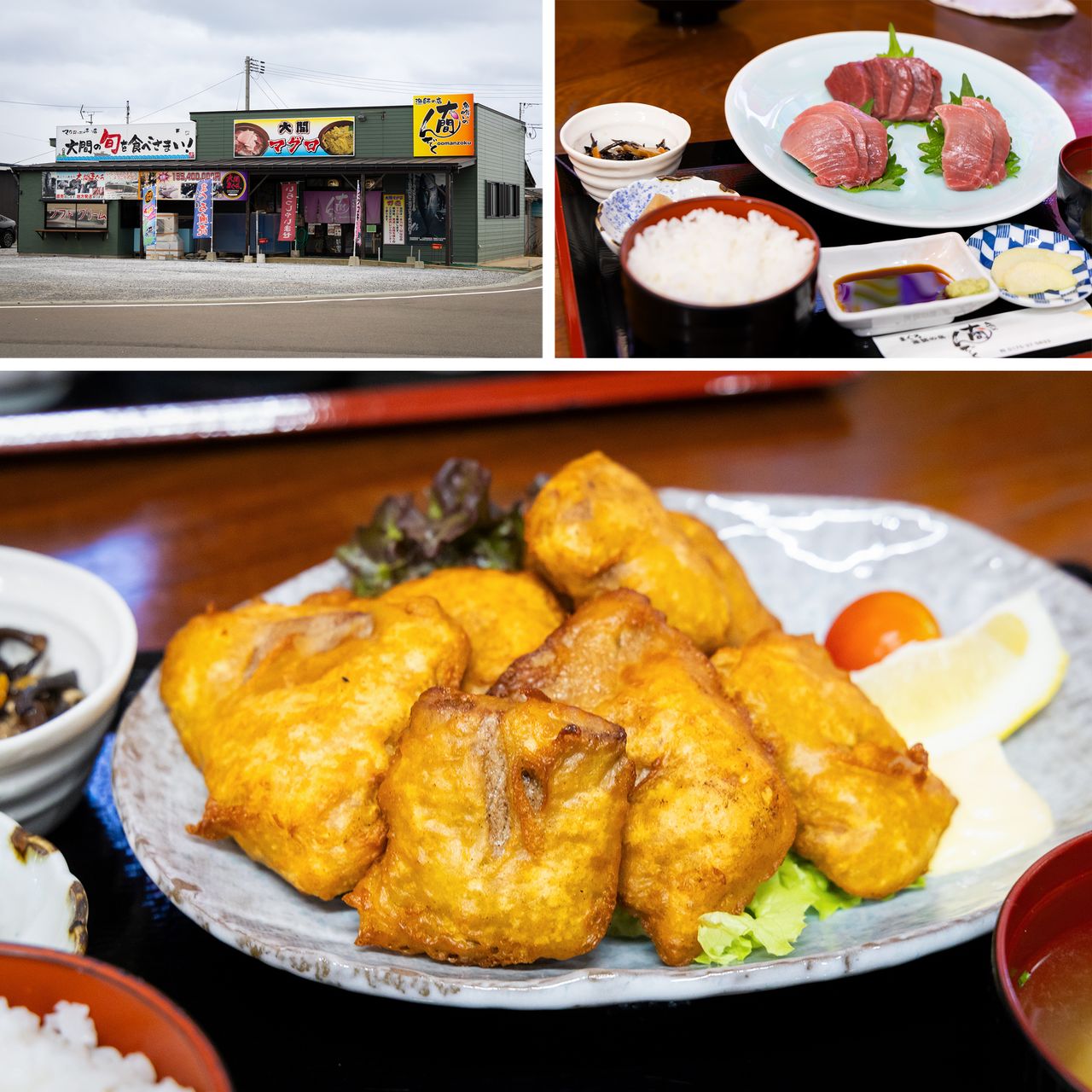
The restaurant Ōmanzoku offers a popular range of satisfying tuna options, including a selection of different cuts of tuna (top right, ¥3,960) and various tuna rice bowls (¥3,960) and sashimi teishoku sets. Deep-fried tuna is also on the menu. (© Nippon.com)
Fresh Sushi in the Shadow of the Port
If you visit during the tuna season, you may be lucky enough to see the catch being brought ashore. Visitors are allowed to watch and take pictures from the wharf in front of the harbor’s Fisheries Cooperative, as long as they don’t get in the way. The main fishing methods used in Ōma are ippon-zuri (single rod and line), and a longline technique called haenawa, which uses a long mainline with baited hooks attached at regular intervals using shorter branch lines. These methods are preferred because they make it easier to haul in a large catch without damaging the fish, ensuring the highest possible price at market.
Special events offer an opportunity to see demonstrations of how huge tuna are dissected and filleted, including the Blue Marine Festival held in the Kyūrei (cold storage warehouse) in the harbor during the midsummer Obon holidays, and “Maguro Day” events held each Sunday in September and October. It is worth making an effort to be in town at these times for a catch a glimpse of the fishing port at work.
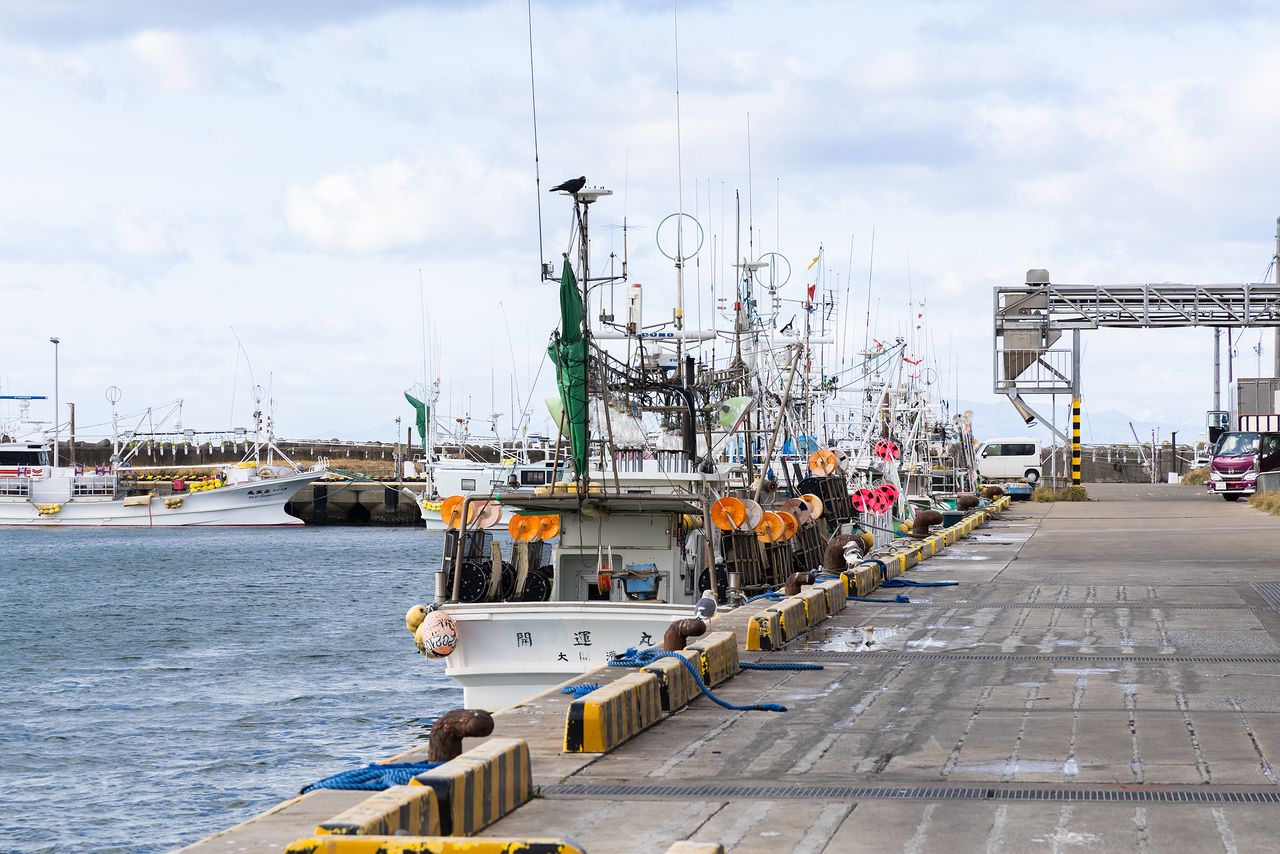
The quay in front of the Ōma Fisheries Cooperative. (© Nippon.com)

A newly landed tuna is hoisted up by crane. The local fishing methods make it possible to haul in even the largest catch without damaging the fish. (© Amazing Aomori)
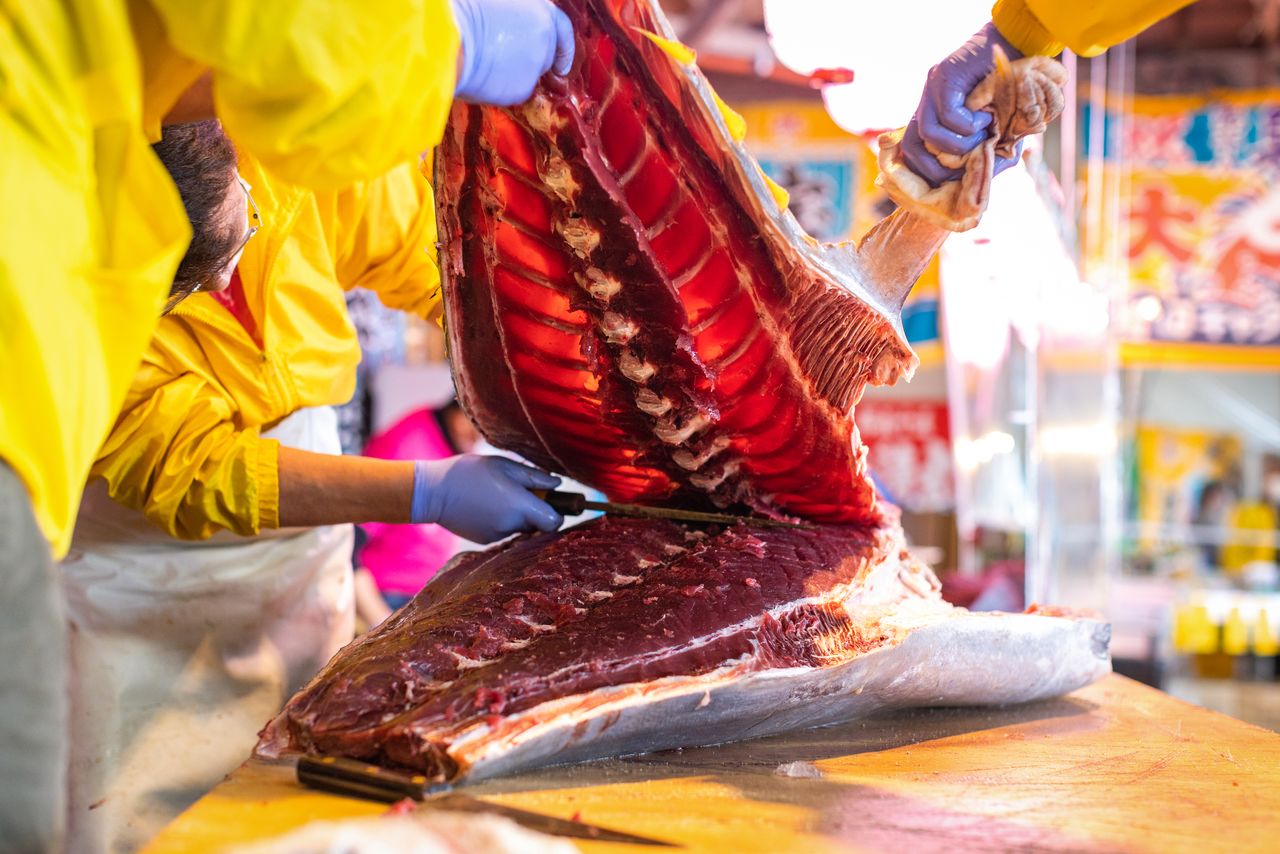
A worker gets to work on a tuna carcass as part of a show at a Sunday “Maguro Day” event. (© Amazing Aomori)
Close to the Kyūrei warehouse is Hama-zushi, the perfect destination for those who want to try Ōma tuna as a topping for sushi. The shop’s most popular selection is the hon-maguro nigiri moriawase, which offers generous servings of ōtoro and chūtoro as well as akami (lean tuna) and a tekka-maki tuna roll for ¥5,940.
Owner Itō Masato says, “If you served this in Tokyo, it would cost at least twice as much—and probably three times as much in a restaurant in Ginza. Customers often say, ‘There’s no way I can eat that much,’ but they always polish it off without any problem. You have no idea how good tuna can be until you’ve tried it here!”

Hama-zushi’s selection of different cuts of tuna sushi is the ideal way to savor the local delicacy. Goes well with a few glasses of local sake! (© Nippon.com)
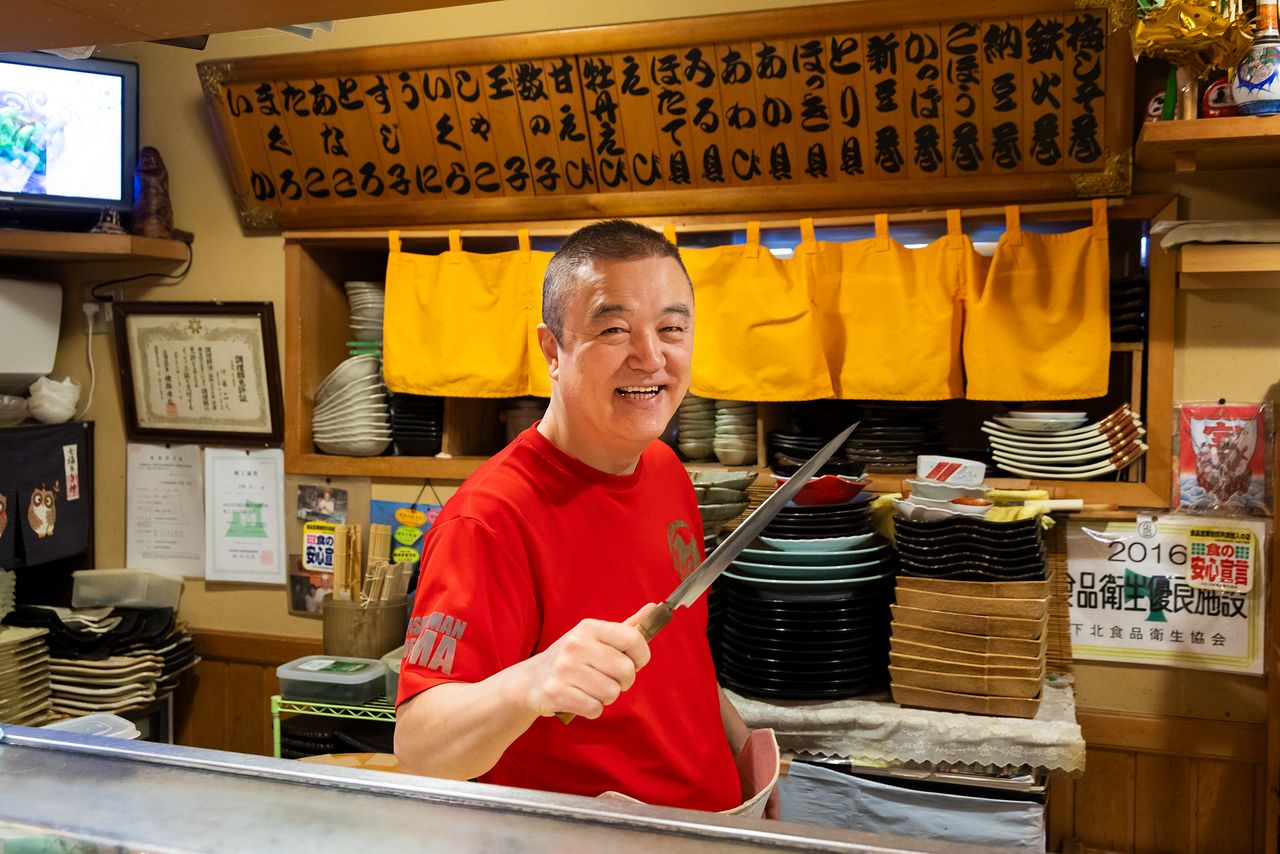
Restaurant owner Itō Masato ensures that the local tuna is always served at its best. (© Nippon.com)
Scenic Views and Healing Onsen
The area around Hama-sushi is redolent with the nostalgic atmosphere of an old-time fishing port, and nearby Oyafukō street, lined with unpretentious eating and drinking establishments, is the center of the town’s nightlife.
A short walk to the south from here is the Ōma Inari Shintō shrine. This unusual shrine is one of relatively few shrines in Japan dedicated to the Daoist goddess Tenpi (Mazu) revered in southern China, Taiwan, and parts of Southeast Asia as the guardian of sailors and fishermen. The famous Tenpi Procession, held on Marine Day (the third Monday in July), brings an exotic splash of color to the streets of the town.
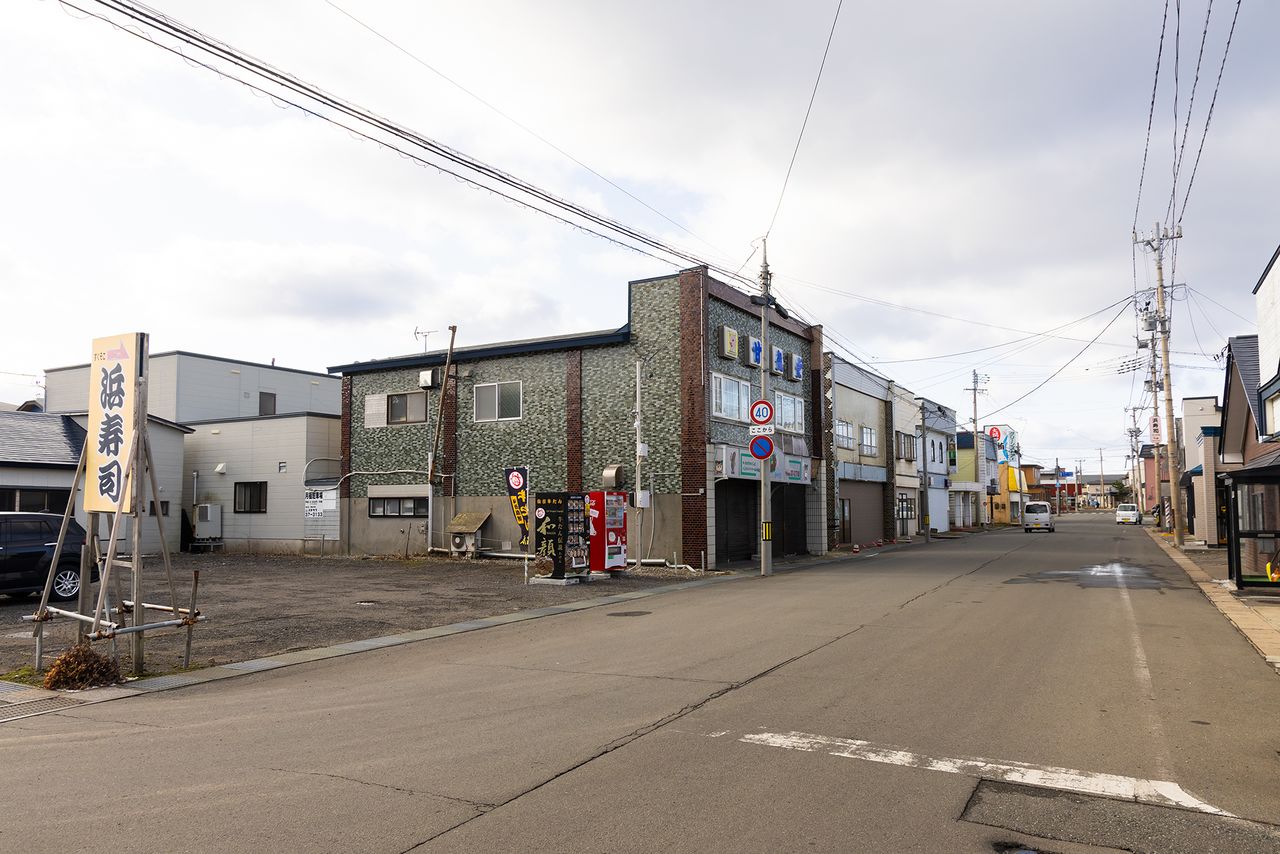
The atmospheric area around the fishing harbor. (© Nippon.com)
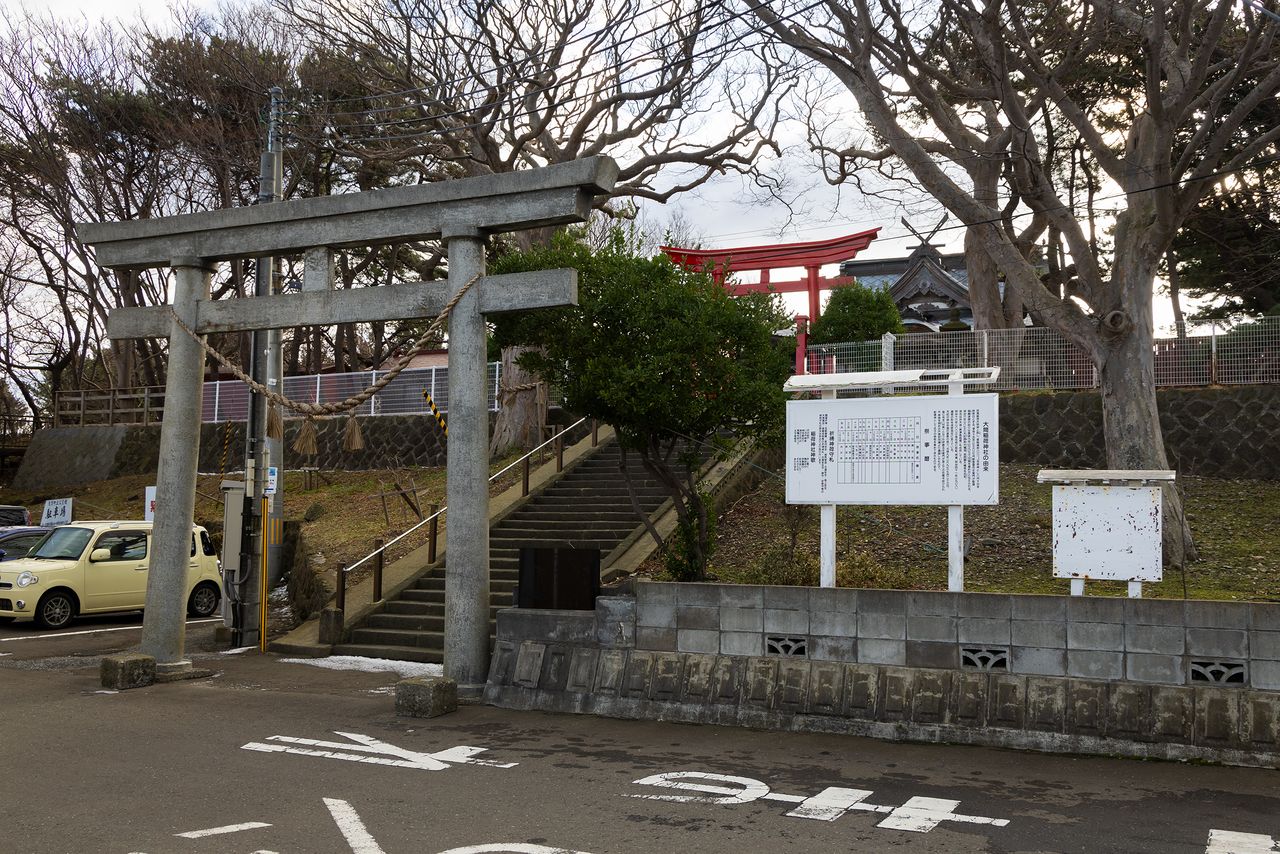
The Ōma Inari Shrine was built in 1730. (© Nippon.com)
Visitors with time to spare might consider making an extending their trip to take in a visit to the natural beauty spot at Hotoke-ga-ura in the nearby village of Sai or Shimofuro Onsen hot springs, in Kazama-ura.
The unusually shaped rock formations at Hotoke-ga-ura reminded people in past centuries of the Pure Land paradises of Mahayana Buddhism, hence the place’s name, which means “Buddha Bay.” Sightseeing boats operate from April to October, allowing visitors to admire the bay and its jade-colored rocks and mountains from the sea. The scenery can be enjoyed year-round, and the remarkable views can be enjoyed even in winter from the viewing deck or by walking down the scenic pathways through the rocks to the beach.
Kazama-ura, where the Shimofuro Onsen hot springs are located, was the setting for Kaikyō (The Strait), a popular novel by the twentieth-century writer Inoue Yasushi. At the Kaikyō no Yu hot springs, named after the novel, visitors can enjoy a relaxing soak in the healing waters, with views out over the Tsugaru Strait.
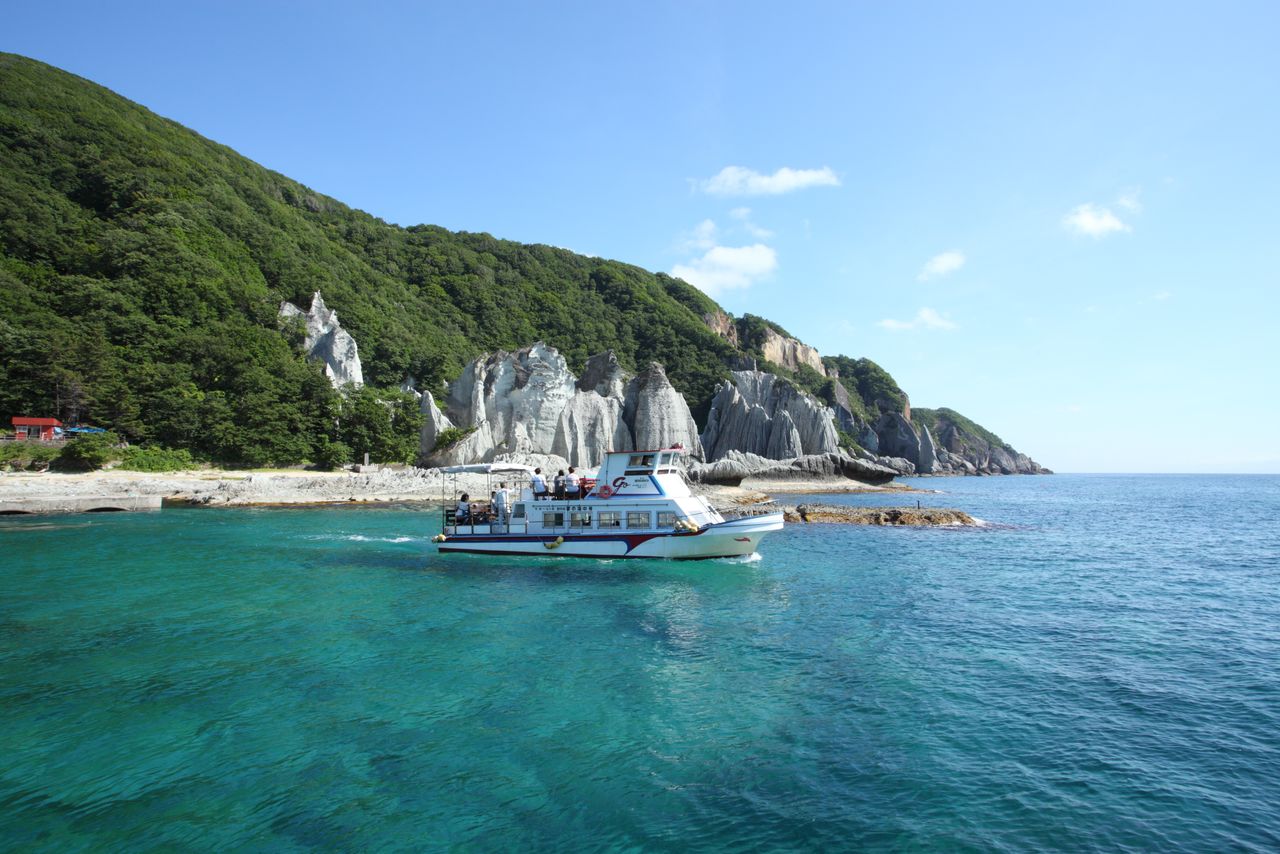
Sightseeing boats leave from Sai port and take around 90 minutes to cruise the scenic scenery of Hotoke-ga-ura, with time for a stroll on the beach. (© Amazing Aomori)
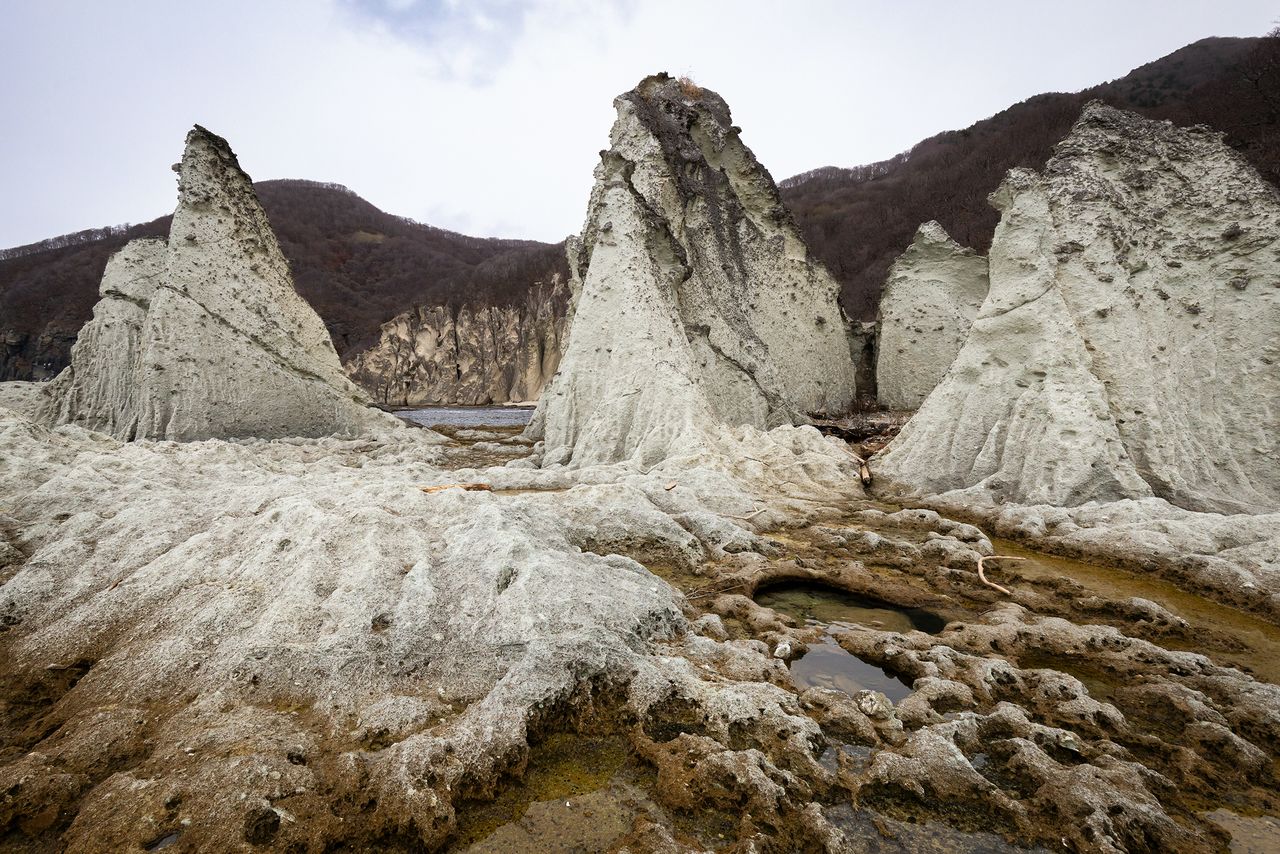
These rock formations are an impressive sight when seen at close quarters. The winding footpath down to the shoreline takes 15 to 20 minutes each way from the parking area. (© Nippon.com)
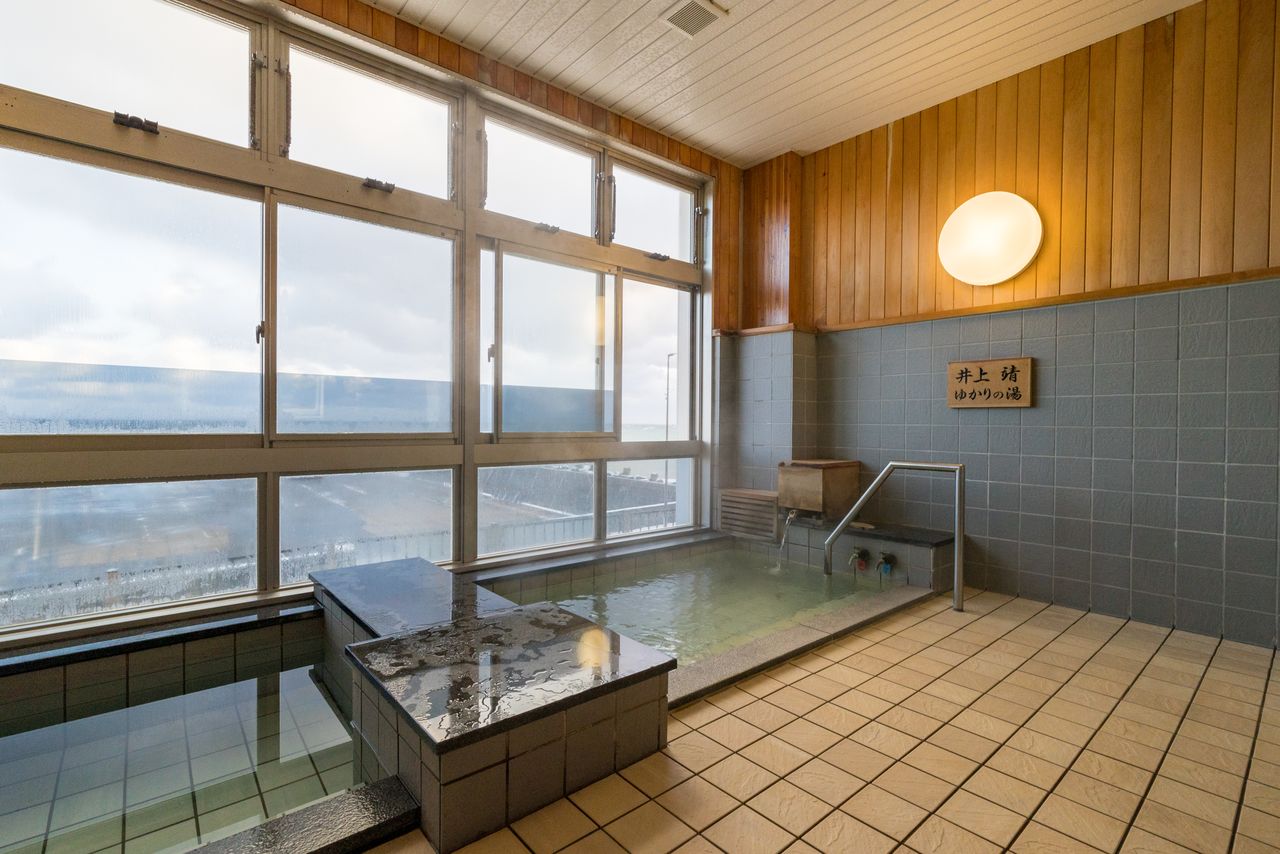
A local onsen offers views out over the Tsugaru Strait. (© Amazing Aomori)
(Originally published in Japanese. Interviews and text by Nippon.com. Banner photo: The view from the northernmost point in Honshū, with the Ōma lighthouse and giant tuna monument. © Nippon.com.)